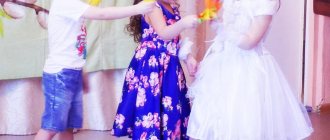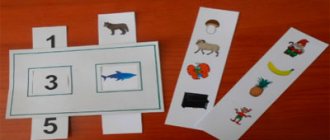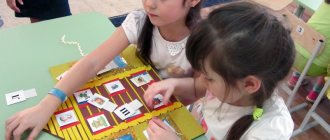Interactive game for children of senior preschool age “Musical Pages”
This resource is intended for children of senior preschool age, but in practice we used it with children of middle preschool age and with children in the group with mental retardation.
This manual includes games and riddles aimed at consolidating knowledge on the topic “Musical Instruments” in a playful way. “Find the extra” Goal: to consolidate the ability to classify and generalize knowledge. children are offered 4 tasks, the child chooses:
Task No. 1 (trombone, flute, pipe, horn, violin) An image of musical instruments appears on the screen, the child must identify the extra instrument, when choosing the wrong answer, the child hears the phrase “Think”, and the image does not disappear, only sways. When choosing the correct answer, the child hears the praise “Well done!” and the extra tool disappears from the screen. To continue, you need to press the arrow to the right; if the child wants to return to the main page, you need to select “House”; if there is a rounded arrow on the task selection page.
“Musical chest” Purpose: to consolidate children’s knowledge of musical instruments, groups of musical instruments, to stimulate auditory attention.
Children are invited to listen to a fragment of the sound of a chosen musical instrument. It is especially interesting for a preschooler to hear the sounds of the chosen musical instrument.
Puzzles. Goal: acquaintance with musical instruments through folk art. The riddles are voiced, the child hears, guesses the riddle and sees a picture - the answer, hears the word and is sure to receive praise.
The games include animation effects, which makes it possible to improve feedback with children and provide more comfortable conditions for conducting classes and an individual approach to learning, allowing you to show the world of music much richer and brighter, and connect visual and auditory ideas.
It should also be taken into account that the duration of classes using a computer for preschool children is in accordance with the requirements of SanPiN.
cannot exceed 7-10 minutes. For the full text of the material Interactive game for children of senior preschool age “Musical Pages”, see the downloadable file
. The page contains a fragment.
| Author: Khvoina N. M., Tveritina G. G. → Publisher 08/18/2017 2 12831 2189 | Comment |
Thank you for your mark. If you want your name to be known to the author, log in to the site as a user and click Thank you again. Your name will appear on this page.
Login | Registration
Have an opinion? Leave a comment
Musical and didactic game “I am a musician” material on music (senior group) on the topic
Ivanova Zhanna Petrovna,
music director of MADOU-kindergarten, Pokachi.
"I am a musician!" Musical and didactic game using ICT
for children of senior preschool age.
The game was developed based on Olga Devochkina’s song “Merry Musicians”. The use of this material will allow the child to feel like a musician - pianist, violinist, drummer... The proposed video series will help children consolidate their knowledge of musical instruments through visual, auditory and motor types of memory. And both adults and children will like the simple rules. The game can be used not only in music classes, but also integrated into various routine moments (free activity, dynamic pause during entertainment, etc.)
Purpose of the game: to create conditions for the creative development of children. Preliminary work: the music director or teacher introduces children to musical instruments (piano/piano, pipe, drum, accordion, balalaika, violin, cymbals) and characteristic movements that imitate ways of playing these instruments. Then he invites the children to watch and listen to O. Devochkina’s song “I am a musician” (video application). The song has 7 verses, in which 7 musical instruments are sung in turn.
Progress of the game:
Option 1:
All children sit in a semicircle in front of the screen and, to the music, pretend to be a musician playing an instrument. To lose, they clap rhythmically.
1st verse – played on the piano (la-la-la) 2nd verse – on the pipe (doo-doo-doo) 3 – on the drum (boom-boom-boom, tra-ta-ta) 4 – on the harmonica (la-la -la) 5 – on the balalaika (trindy-brin) 6 – on the violin (ti-li-li) 7 – on the cymbals (ding-ding)
Option 2:
According to the counting, the first driver is chosen. For the first verse, he goes to the center of the circle and shows all the other children how to play the instrument (the children repeat the movements after him). To lose, the first leader appoints a second driver and joins the general circle. Verse 2 is performed with a new driver. At the end of the 2nd verse, during the loss, the second leader chooses the next leader, etc.
Option 3:
The drivers are selected using a set of cards* (in which 7 cards depicting musical instruments - piano, pipe, drum, accordion, balalaika, violin, cymbals; the remaining cards - with images of palms (or emoticons). The number of cards is determined by the number of players. Before you start games, children sort out the cards. Whoever got the picture with the image of a musical instrument - the drivers, they will go to the center in turn at the beginning of their verse and perform movements in accordance with the meaning of the song. All players are asked to repeat the movements of the driver for the chorus, and clap in rhythm for the loss offered by the driver.
*Appendix – cards with drawings of musical instruments.
(Video - song to music and lyrics by Olga Devochkina,
performed by Buginas Bronislav Kazisovych)
Musical and didactic games in preschool educational institutions
Lyudmila Vilenskaya
Musical and didactic games in preschool educational institutions
Musical and didactic games in kindergarten.
Musical education in kindergarten is carried out mainly in music classes , where, under the guidance of a teacher, the child tries to express himself in singing, dancing, conveying the image of a game , composing a dance - improvisation, playing musical instruments .
The ability to act independently, performing musical tasks , allows children to perform musical material , and contributes to the development of control over their own performance of musical and sensory abilities.
Effective musical -sensory education is facilitated by the visibility of learning, the emergence in the minds of children of natural associations of musical sounds with the sounds of the environment.
In music classes, children develop musical perception . However, it is hardly possible to limit ourselves to this. We also need an environment in which the child could deepen the learned methods of action and practice them independently. We need special educational games and toys . The child encounters music in classes twice a week, where singing and rhythmic skills are mainly taught. In everyday life, musical impressions are not always systematic. Therefore, successful musical development of children requires a special environment. Musical didactic games can be considered as such an environment .
music program notes that the purpose of musical didactic games is to teach a child to distinguish and understand the properties and qualities of perceived phenomena.
Musical and didactic games always contain the development of action, which combines elements of entertainment and competition with sensory tasks. The purpose of the play activities is to help the child hear, distinguish, and compare the properties of musical sounds : their pitch, strength, duration, timbre. of musical regularly carried out with children help the systematic development of musical hearing , develop the ability to distinguish between changes in register, dynamics, and rhythm in the same work. In addition, musical and didactic games and exercises using tabletop material allow children to independently practice mastering the methods of sensory actions.
Types of musical and didactic games and methods of their implementation.
Depending on the didactic task and the deployment of game actions, musical didactic games are usually divided into three types:
1. Calm music playing.
2. A game of the mobile type, where the element of competition in dexterity is postponed in time from the moment of performing musical tasks .
3. Games built like round dances.
In games of the first type, the static behavior of children divided into
subgroups. The competitive element lies in the ability to quickly and accurately identify a piece of music .
These games are often played with aids. For the best performance of the task, a subgroup of children or a child is awarded a point, chip or flag. During the game, children follow its rules, showing one or another picture.
The second type of didactic games is characterized by the dynamics of actions. The game is similar to an outdoor one. Children, divided into subgroups, listen to the sound of music and react with movements. Loud sounds sound - one group of children moves, quiet sounds - another, and the first one stops.
In didactic games of the third type, children's motor activity is limited. (circle) compete with each other.
and soloist. For example, children of the first circle respond to high sounds, children of the second circle respond to sounds of the middle register, and children of the third circle respond to sounds of a low register. The winners are the children of the circle who responded more accurately to the change in sound.
A musical didactic game requires auditory concentration, which leads to improved development of auditory perception. During the game , the child must listen to the change in sound and respond to it with movement or action.
For example, in the first type of play, children learn to distinguish the timbre of a drum, rattle, and pipe. The teacher creates three subgroups. The first subgroup reacts to the sound of the drum with appropriate movements, the second - when the rattle sounds, they wave their hands, the third - when the pipe sounds, they imitate playing the pipe. The teacher varies the sequence of sounds of instruments at his own discretion. At the end of the game the winners are celebrated.
Methodology for conducting games of the third type (such as round dances)
is similar, but they feature more competition in agility and superiority in formation.
In all types of musical and didactic games, their rules are closely related to the quality of fulfillment of sensory tasks and are aimed at encouraging children who accurately complete them.
The easiest way for preschool children to perceive sound-altitude relationships. Therefore, musical didactic exercises with distinguishing the pitch of sounds ( “Three Bears”
,
“Which bell sounds?”
).
Simultaneously with conducting musical -didactic game exercises, you can introduce musical -didactic tasks to distinguish not only the basic properties of sound (strength, height, duration, timbre, but also means of musical expressiveness , genres of musical works . For example, in the older group to distinguish between cheerful and calm nature of the music musical instruments are used to perform these tasks boxes and phonograms.Musical
and didactic material for games are songs, instrumental works, a set of musical instruments .
Examples of developments musical and didactic games.
Game "Funny nesting dolls"
.
Program content: Teach children to distinguish sounds by pitch.
Game aids: Matryoshka dolls of three sizes: tall - in green sundresses and scarves, medium - in blue, short - in red. Quantity – according to the number of players. Flowers blue, red, green (three)
Game progress : 1st option. The children sit in three subgroups, holding nesting dolls in their hands. The first subgroup has high values, the second has medium values, and the third has low values. The teacher invites the children to let the nesting dolls dance. But to do this, you need to listen carefully to what register the music . If in low, low nesting dolls are dancing, if in high, high matryoshkas are dancing, if in medium, medium matryoshkas are dancing. At the end, the winning team is celebrated.
Option 2. in different places the music hall. Children with matryoshka dolls in their hands are grouped into three teams according to the color of the dolls. The teacher invites children to respond to the sound of music by dancing , moving around within the group. Children with high nesting dolls dance to high sounds, with medium matryoshkas to middle sounds, with low nesting dolls to low sounds. When changing registers, only one subgroup dances, the rest stop at the place where they were caught by the change in sound. At the end of the music, each group of children should gather around their flower.
Option 3. Children with nesting dolls in their hands stand around three flowers. React to changes in music similarly to the previous options (in terms of pitch of sounds)
go in circles.
Game “Find out what instrument sounds?”
Program content: Teach children to distinguish the timbre of musical instruments .
Game aids: Cards with the image of a triangle, a tambourine, a metallophone for each player.
Musical and didactic material: Triangle, tambourine, metallophone.
Game progress : 1st option. Children are sitting at tables. Each person has a set of cards in front of them. The tools are blocked by a screen. Children pick up a card with a picture of the instrument that sounds.
Option 2. Children line up in three columns. The children of the first column dance to the sounds of the triangle. To the sounds of a tambourine - the second column, to the sounds of a metallophone - the third column.
Option 3. Children sit in three circles. Children of the first circle move at a light jog to the sound of the triangle and freeze in place to the sound of other instruments. Children of the second circle march to the sound of a tambourine. Children of the third circle perform jumps to the sound of a metallophone.
Game "Bells"
.
Program content: Teach children to distinguish the strength of sound.
Play aids: Sets of flat bells of large, medium and small sizes according to the number of children. Bells on stands.
Musical and didactic material: tambourine.
Game progress : 1st option. Children sit in three rows. Small bells are given to the first row, medium bells to the second, and large bells to the third. For a loud sound, raise the top of large bells, for a moderately loud sound - medium-sized bells, for a quiet sound - small bells. The teacher plays, changing the sequence of sounds of different strengths. A number of winners are noted.
Option 2. Children are divided into three teams. Each team stands in a circle near its attribute - a large, medium and small bell. When loud sounds sound, children standing around the large bell stomp in place; when moderate sounds sound, children standing around the middle bell march in a circle. When playing quiet sounds, children standing around a small bell perform a light run in a circle.
Option 3. Children stand in three circles near their attributes, holding hands. Children from one circle move to loud sounds with a stomping step, to sounds of medium volume - children from another circle, and to quiet sounds - children from the third circle walk easily on their toes.
Game "Three Bears"
.
Program content: Teach children to distinguish the pitch of sounds.
Game aids: Plane images of bears of large, medium and small sizes, three for each child, a plane house.
Musical and didactic material: “Bear”
muses by A. Rauchwerger.
The game can be played using bells of different sizes.
Game progress : 1st option. Children are given pictures of bears. When the piece sounds in a high register, the bear cubs come out for a walk, when it is in the middle register, the bigger bears, and when in the low register, the big ones.
Option 2. Children are divided into teams and pretend to be bears to the appropriate music . At the end, Michal Ivanych catches the rest of the bears.
Option 3 is played according to the type of game “Whose circle will gather faster”
Game "Sea and Stream"
.
Program content: Teach children to distinguish the tempo of music .
Game aids: Sets of pictures depicting sea waves and a stream.
Musical and didactic material: “Running”
music
E. Tilicheeva, “French folk melody”
arr. Alexandrova, piano, phonogram.
Game progress : 1st option. The children are arranged in two semicircles. In the hands of children in one semicircle there are pictures with the image of a stream, in the other - with the image of sea waves. When a piece of fast tempo is played, children should raise pictures with the image of a stream, when slow - with the image of the sea.
Option 2. Children are divided into two teams: “stream”
and
sea"
.
When playing a piece of slow tempo, the “sea”
moves using smooth movements forward and backward.
When a piece of fast tempo is played, the command “stream”
moves lightly in a circle.
At the end “sea”
team
“stream”
team .
Option 3. Children stand in two circles. When the piece is played slowly, the children of the “sea”
Slowly raise and lower your clasped hands. When the piece is playing quickly, children perform light lateral gallop movements in a circle.
Guess game.
Program content: Teach children to distinguish the duration of sounds.
Game aids: Cut out paper circles, large and small, white and black, according to the number of children.
Musical and didactic material: tambourine or drum.
Game progress : 1st option. Children are divided into two teams. One team has white circles in their hands, the other has black circles. It is proposed to raise large white circles when performing long sounds, and small black circles when performing short sounds. The teacher repeatedly changes the duration of the sound without stopping and monitors the children’s correct execution of the task.
Option 2. Children line up in two lines. When long sounds are sounded, the children of the first team move in different directions; when short sounds are sounded, the children of the second team move. At this time, the children of the first team stop at the places where the sound duration changed.
Option 3. Children stand in two circles. When long sounds are heard, children in the first circle move in slow steps. When short sounds are heard, children in the second circle perform light jumps. The sounds are played in different sequences.






